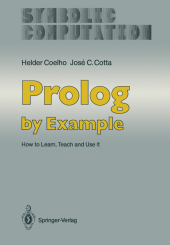 Neuerscheinungen 2011Stand: 2020-01-07 |
Schnellsuche
ISBN/Stichwort/Autor
|
Herderstraße 10
10625 Berlin
Tel.: 030 315 714 16
Fax 030 315 714 14
info@buchspektrum.de |

Helder Coelho, Jose C. Cotta
(Beteiligte)
Prolog by Example
How to Learn, Teach and Use It
Softcover reprint of the original 1st ed. 1988. 2011. x, 382 S. 68 figs. X, 382 pages. 244 mm
Verlag/Jahr: SPRINGER, BERLIN 2011
ISBN: 3-642-83215-6 (3642832156)
Neue ISBN: 978-3-642-83215-4 (9783642832154)
Preis und Lieferzeit: Bitte klicken
Prolog has a declarative style. A predicate definition includes both the input and output parameters, and it allows a programmer to define a desired result without being concerned about the detailed instructions of how it is to be computed. Such a declarative language offers a solution to the software crisis, because it is shorter and more concise, more powerful and understandable than present-day languages. Logic highlights novel aspects of programming, namely using the same program to compute a relation and its inverse, and supporting deductive retrieval of informa tion. This is a book about using Prolog. Its real point is the examples introduced from Chapter 3 onwards, and so a Prolog programmer does not need to read Chapters 1 and 2, which are oriented more to teachers and to students, respec tively. The book is recommended for introductory and advanced university courses, where students may need to remember the basics about logic program ming and Prolog, before starting doing. Chapters 1 and 2 were also kept for the sake of unity of the whole material. In Chapter 1 a teaching strategy is explained based on the key concepts of Pro log which are novel aspects of programming. Prolog is enhanced as a computer programming language used for solving problems that involve objects and the relationships between objects. This chapter provides a pedagogical tour of pre scriptions for the organization of Prolog programs, by pointing out the main draw backs novices may encounter.
1 Teaching Prolog.- 2 One or Two Things About Prolog.- 3 Using Prolog.- 4 Proving with Prolog.- 5 Doing Arithmetic with Prolog.- 6 Doing Algebra with Prolog.- 7 Playing with Prolog.- 8 Searching with Prolog.- 9 Learning with Prolog.- 10 Modeling with Prolog.- 11 Designing with Prolog.- 12 Drawing with Prolog.- 13 Planning with Prolog.- 14 Seeing with Prolog.- 15 Engineering Grammars with Prolog.- 16 Constructing Personal Databases with Prolog.- 17 Text Formatting with Prolog.- 18 Management with Prolog.- 19 Building Up with Prolog.- Acknowledgments.- Appendix 1 Prolog Implementations.- Appendix 2 Commercial Products.- Appendix 3 Selection of Some Historical Prolog Applications.- References.


